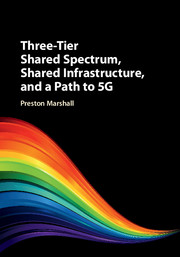Book contents
- Frontmatter
- Contents
- Acknowledgments
- Preface
- Part I Spectrum Sharing Background
- Part II Three-Tier Dynamic Spectrum Models
- Part III Components of a Three-Tier Architecture
- Part IV Protection Processes for Incumbents and Peers
- 8 General Process for Database System Operation
- 9 Protection of Incumbent Satellite Operations
- 10 Protection to and From Terrestrial Access Points and Point-to-Point Networks
- 11 Protection to and From Radar Systems
- 12 Coexistence Between Unprotected Peer Devices
- Part V Example Use of Three-Tier Spectrum: Use of the 3.5 GHz CBRS Band in the USA
- Part VI Future Bands, Network Services, Business Models, and Technology
- Part VII Appendices
- Index
- References
12 - Coexistence Between Unprotected Peer Devices
from Part IV - Protection Processes for Incumbents and Peers
Published online by Cambridge University Press: 30 August 2017
- Frontmatter
- Contents
- Acknowledgments
- Preface
- Part I Spectrum Sharing Background
- Part II Three-Tier Dynamic Spectrum Models
- Part III Components of a Three-Tier Architecture
- Part IV Protection Processes for Incumbents and Peers
- 8 General Process for Database System Operation
- 9 Protection of Incumbent Satellite Operations
- 10 Protection to and From Terrestrial Access Points and Point-to-Point Networks
- 11 Protection to and From Radar Systems
- 12 Coexistence Between Unprotected Peer Devices
- Part V Example Use of Three-Tier Spectrum: Use of the 3.5 GHz CBRS Band in the USA
- Part VI Future Bands, Network Services, Business Models, and Technology
- Part VII Appendices
- Index
- References
Summary
The Role of Coexistence in Spectrum Protection Systems
One of the desirable features of the three-tier regime is that it offers the opportunity for network operators to acquire protection of their nodes from interference. This feature is judged to be essential to creating confidence in the investment in these bands. However, it is not clear that paying for protection in small segments of the spectrum is a superior solution to other methods of assuring a dependable level of service. In this chapter, we will investigate the conceptual basis of alternatives to protected mid-tier status, and investigate methods of implementing them.
Use of protected status has a number of disadvantages:
• The amount of spectrum that can be acquired in a protected status may be relatively small compared to the spectral bandwidth that is available in the sharable band.
• The cost of the protection may be high compared to the access devices, and may create significant disadvantages to the economics of the deployment.
• The use of a specific frequency that is accorded protectionmight limit the flexibility of the network to deal with conditions such as strong adjacent channel signals, primary spectrum reclaiming events, and network spectrum reuse strategies.
• Protection of large areas is inappropriate for many small/femto cell deployment cases, such as indoor and three-dimensional deployments. It adds an unnecessary cost burden to the second tier, and limits access to spectrum by the third tier.
For these reasons, this chapter will investigate methods of achieving high levels of predictability in spectrum access effectiveness that do not require explicit grants of protection or elevation in rights, and minimize the extent of spectrum that is committed to elevated rights usage.
Model for Coexistence Services
Our model for coexistence has two possible levels of operation.
Partitioning Partitioned use divides the available spectrum resources in a given location between a number of networks that desire spectrum, and are willing to enter into an agreement to coexist with each other. This sharing makes no assumptions on the technology used, or on the operation of the technology within the allocated channels.
Information
- Type
- Chapter
- Information
- Publisher: Cambridge University PressPrint publication year: 2017
